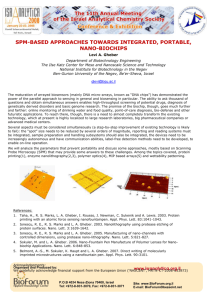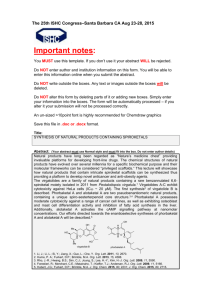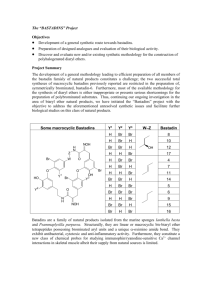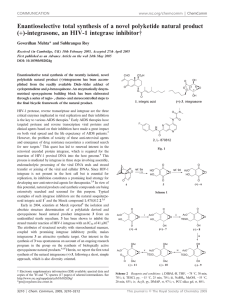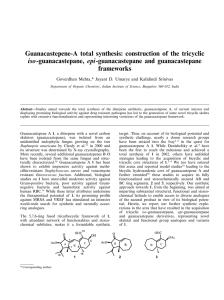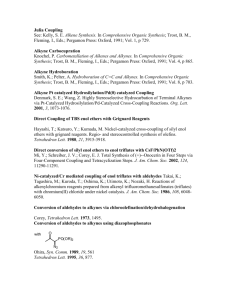A total synthesis of guanacastepene C{
advertisement
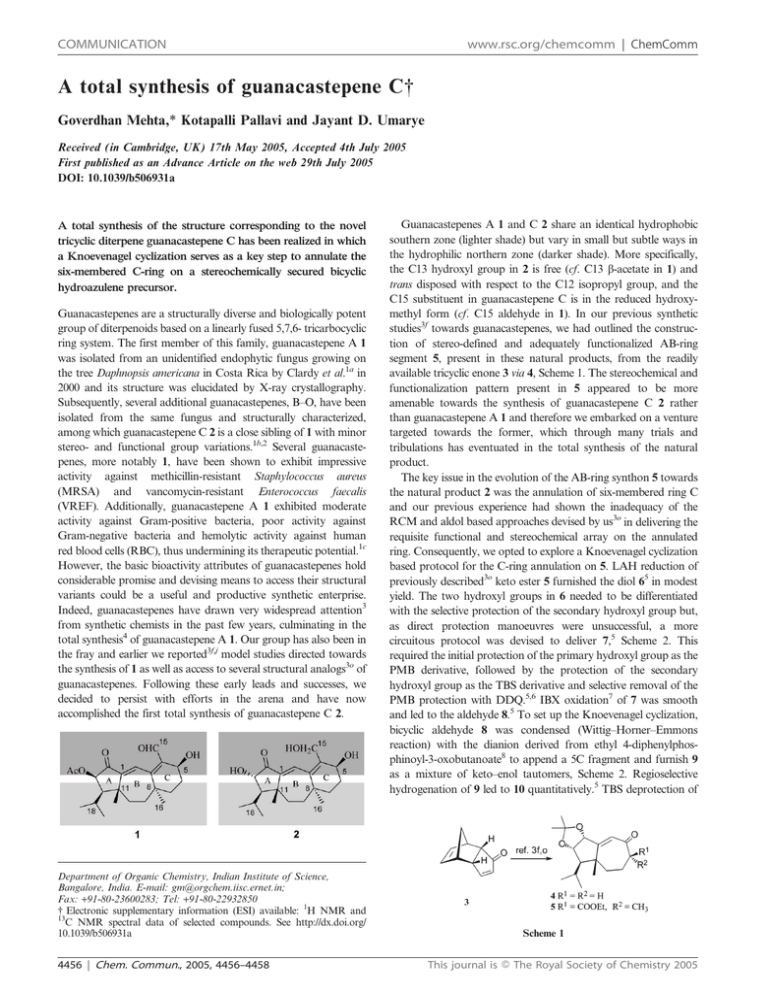
COMMUNICATION
www.rsc.org/chemcomm | ChemComm
A total synthesis of guanacastepene C{
Goverdhan Mehta,* Kotapalli Pallavi and Jayant D. Umarye
Received (in Cambridge, UK) 17th May 2005, Accepted 4th July 2005
First published as an Advance Article on the web 29th July 2005
DOI: 10.1039/b506931a
A total synthesis of the structure corresponding to the novel
tricyclic diterpene guanacastepene C has been realized in which
a Knoevenagel cyclization serves as a key step to annulate the
six-membered C-ring on a stereochemically secured bicyclic
hydroazulene precursor.
Guanacastepenes are a structurally diverse and biologically potent
group of diterpenoids based on a linearly fused 5,7,6- tricarbocyclic
ring system. The first member of this family, guanacastepene A 1
was isolated from an unidentified endophytic fungus growing on
the tree Daphnopsis americana in Costa Rica by Clardy et al.1a in
2000 and its structure was elucidated by X-ray crystallography.
Subsequently, several additional guanacastepenes, B–O, have been
isolated from the same fungus and structurally characterized,
among which guanacastepene C 2 is a close sibling of 1 with minor
stereo- and functional group variations.1b,2 Several guanacastepenes, more notably 1, have been shown to exhibit impressive
activity against methicillin-resistant Staphylococcus aureus
(MRSA) and vancomycin-resistant Enterococcus faecalis
(VREF). Additionally, guanacastepene A 1 exhibited moderate
activity against Gram-positive bacteria, poor activity against
Gram-negative bacteria and hemolytic activity against human
red blood cells (RBC), thus undermining its therapeutic potential.1c
However, the basic bioactivity attributes of guanacastepenes hold
considerable promise and devising means to access their structural
variants could be a useful and productive synthetic enterprise.
Indeed, guanacastepenes have drawn very widespread attention3
from synthetic chemists in the past few years, culminating in the
total synthesis4 of guanacastepene A 1. Our group has also been in
the fray and earlier we reported3f,j model studies directed towards
the synthesis of 1 as well as access to several structural analogs3o of
guanacastepenes. Following these early leads and successes, we
decided to persist with efforts in the arena and have now
accomplished the first total synthesis of guanacastepene C 2.
Department of Organic Chemistry, Indian Institute of Science,
Bangalore, India. E-mail: gm@orgchem.iisc.ernet.in;
Fax: +91-80-23600283; Tel: +91-80-22932850
{ Electronic supplementary information (ESI) available: 1H NMR and
13
C NMR spectral data of selected compounds. See http://dx.doi.org/
10.1039/b506931a
4456 | Chem. Commun., 2005, 4456–4458
Guanacastepenes A 1 and C 2 share an identical hydrophobic
southern zone (lighter shade) but vary in small but subtle ways in
the hydrophilic northern zone (darker shade). More specifically,
the C13 hydroxyl group in 2 is free (cf. C13 b-acetate in 1) and
trans disposed with respect to the C12 isopropyl group, and the
C15 substituent in guanacastepene C is in the reduced hydroxymethyl form (cf. C15 aldehyde in 1). In our previous synthetic
studies3f towards guanacastepenes, we had outlined the construction of stereo-defined and adequately functionalized AB-ring
segment 5, present in these natural products, from the readily
available tricyclic enone 3 via 4, Scheme 1. The stereochemical and
functionalization pattern present in 5 appeared to be more
amenable towards the synthesis of guanacastepene C 2 rather
than guanacastepene A 1 and therefore we embarked on a venture
targeted towards the former, which through many trials and
tribulations has eventuated in the total synthesis of the natural
product.
The key issue in the evolution of the AB-ring synthon 5 towards
the natural product 2 was the annulation of six-membered ring C
and our previous experience had shown the inadequacy of the
RCM and aldol based approaches devised by us3o in delivering the
requisite functional and stereochemical array on the annulated
ring. Consequently, we opted to explore a Knoevenagel cyclization
based protocol for the C-ring annulation on 5. LAH reduction of
previously described3o keto ester 5 furnished the diol 65 in modest
yield. The two hydroxyl groups in 6 needed to be differentiated
with the selective protection of the secondary hydroxyl group but,
as direct protection manoeuvres were unsuccessful, a more
circuitous protocol was devised to deliver 7,5 Scheme 2. This
required the initial protection of the primary hydroxyl group as the
PMB derivative, followed by the protection of the secondary
hydroxyl group as the TBS derivative and selective removal of the
PMB protection with DDQ.5,6 IBX oxidation7 of 7 was smooth
and led to the aldehyde 8.5 To set up the Knoevenagel cyclization,
bicyclic aldehyde 8 was condensed (Wittig–Horner–Emmons
reaction) with the dianion derived from ethyl 4-diphenylphosphinoyl-3-oxobutanoate8 to append a 5C fragment and furnish 9
as a mixture of keto–enol tautomers, Scheme 2. Regioselective
hydrogenation of 9 led to 10 quantitatively.5 TBS deprotection of
Scheme 1
This journal is ß The Royal Society of Chemistry 2005
Scheme 2 Reagents and conditions: i, LiAlH4, THF, 0 uC to rt, 2 h, 55%; ii, a. PMBCl, THF, NaH, TBAI, 0 uC to rt, 5 h, 67%; b. TBSOTf, 2,6-lutidine,
DCM, 0 uC, 15 min, 68%; c. DDQ, DCM–H2O (25:1), rt, 2 h, 95%; iii, IBX, toluene–DMSO (4:1), rt, 3 h, 92%; iv, Ph2POCH2COCH2COOEt, NaH,
nBuLi, THF, 0 uC to rt, 6 h, 86%; v, H2, EtOAc, 5% Pd/C (10% w/w), 30 min, rt, quant.; vi, a. 6 N H2SO4, THF–H2O (4:1), rt, 18 h, 80%; b. 2,2-DMP,
PPTS, rt, 45 min, 91%; vii, PCC, NaOAc, molecular sieve powder (4 Å), DCM, rt, 12 h, 80%; viii, DBU, benzene, 65 uC, 12 h, 82%.
10 led to concomitant acetonide deprotection and intramolecular
hemiketalization and the 1,2-diol moiety in the resultant product
was reprotected to give 11, Scheme 2. PCC oxidation of 11
furnished the b-keto ester precursor 125 for the Knoevenagel
cyclization. As envisaged, 12, on exposure to DBU, underwent
smooth cyclization to generate the C-ring and delivered 135
embodying the complete tricarbocyclic framework of guanacastepenes, Scheme 2.
In the dienone ester 13, we had in place the three rings and all
the functional elements for further elaboration to the natural
product 2 and the main task ahead was functional group
adjustments. LAH reduction of 13 led to 14 as a predominant
C5 a-OH isomer (vide infra), albeit in moderate yield, Scheme 3.
The diol moiety in 14 was protected as the diacetate 15 and acid
hydrolysis of the acetonide functionality gave a 4:1 mixture of the
diol 17 and the triol 16. Fortunately, triol 16 provided good
crystals for X-ray crystal structure determination9 and this among
Scheme 3 Reagents and conditions: i, LiAlH4, THF, 278 uC to rt, 1 h,
65%; ii, Ac2O, NEt3, DMAP, DCM, 5 h, 92%; iii, 4 N H2SO4, THF–H2O
(4:1), rt, 8 h, 75% of 17 and 20% of 16; iv, DDQ, THF, 65 uC, 6 h, 80%.
This journal is ß The Royal Society of Chemistry 2005
other things revealed the undesired nature of the C5 hydroxyl
stereochemistry. DDQ mediated10 chemoselective allylic oxidation
of 17 furnished 18,5 formally a 5-epi-guanacastepene C diacetate,
Scheme 3. The elaboration of 14 to 18 paved the way for a final
assault on the natural product 2 and mandated the inversion of C5
a-OH stereochemistry.
Consequently, diol 14 was subjected to the standard Mitsunobu
protocol to furnish the dibenzoate 19 in fair yield, Scheme 4. The
acetonide protecting group was now disengaged to give 20 and
further chemoselective oxidation10 of the allylic hydroxyl group
delivered the guanacastepene C dibenzoate 21, Scheme 4. At this
stage hydrolysis of the benzoate ester groups was expected to
deliver the natural product 2. However, for reasons not quite
obvious to us, this seemingly straightforward transformation
frustrated us to no end and forced us to explore an alternate
circuitous route. Thus, the dibenzoate 19 was hydrolyzed to the
diol 22 and the hydroxyl groups were reprotected as the diacetate
23, Scheme 4. Deprotection of the acetonide group, even under the
most carefully monitored reaction regime, led to some concurrent
acetate hydrolysis and a 62:38 mixture of the desired diol diacetate
24 and the triol 25 was obtained. Chemoselective allylic oxidation
of 24 led to the guanacastepene C diacetate 26 whose spectral
data2 was distinctly different from its C5-epimer 18.5 Further
careful hydrolysis of 26 delivered a compound corresponding to
the reported structure of guanacastepene C 2, Scheme 4. However,
as a direct spectral comparison with the natural product was not
possible, our arrival at 2 has been inferred from the internal
consistency of our synthetic sequence and the limited spectral
data.11
In summary, we have crafted an access to the 5,7,6-fused
tricyclic framework of guanacastepene diterpenes from a readily
available hydroazulenic precursor employing a Knoevenagel
cyclization as the key step and further elaborated this
advanced intermediate towards the diterpenoid natural product
guanacastepene C.
Chem. Commun., 2005, 4456–4458 | 4457
Scheme 4 Reagents and conditions: i, PPh3, C6H5COOH, DIAD, THF, 278 uC to rt, 2 h, 78%; ii, 2 N HCl, THF, rt, 6 h, 61%; iii, DDQ, THF, 65 uC, 6 h,
76%; iv, LiAlH4, THF, 0 uC to rt, 30 min, 84%; v, Ac2O, NEt3, DMAP, DCM, rt, 5 h, 90%; vi, 4 N H2SO4, THF–H2O (4:1), rt, 6 h, 44% of 24 and 28% of
25; vii, DDQ, THF, 65 uC, 6 h, 85%; viii, K2CO3, MeOH, 0 uC to 15 uC, 2 h, 70%.
This research was supported by the Chemical Biology Unit of
JNCASR, Bangalore and CSIR (fellowships to KP and JDU),
India. We thank SIF and CCD facility at IISc for their help.
4
Notes and references
1 (a) S. F. Brady, M. P. Singh, J. E. Janso and J. Clardy, J. Am. Chem.
Soc., 2000, 122, 2116; (b) S. F. Brady, S. M. Bondi and J. Clardy, J. Am.
Chem. Soc., 2001, 123, 9900; (c) M. P. Singh, J. E. Janso,
S. W. Luckman, S. F. Brady, J. Clardy, M. Greenstein and
W. M. Maiese, J. Antibiot., 2000, 53, 256.
2 The structure elucidation of guanacastepenes presented a considerable
challenge in view of the dynamic conformational equilibrium around the
C9–C10 bond at the bottom of the seven-membered ring, as a
consequence of which the 1H and 13C NMR spectra of these
diterpenoids showed an unpredictable number of signals as well as
significant variation with solvent and temperature, severely limiting the
reliability of spectral data in structure elucidation. Structures in many
cases were therefore determined through low temperature crystallization
and X-ray diffraction studies1a,b.
3 (a) B. B. Snider and B. Shi, Tetrahedron Lett., 2001, 42, 9123; (b)
B. B. Snider and N. A. Hawryluk, Org. Lett., 2001, 3, 569; (c)
P. Magnus, M. J. Waring, C. Ollivier and V. Lynch, Tetrahedron Lett.,
2001, 42, 4947; (d) G. B. Dudley and S. J. Danishefsky, Org. Lett., 2001,
3, 2399; (e) G. B. Dudley, D. S. Tan, G. Kim, J. M. Tanski and
S. J. Danishefsky, Tetrahedron Lett., 2001, 42, 6789; (f) G. Mehta and
J. D. Umarye, Org. Lett., 2002, 4, 1063; (g) T. M. Nguyen and D. Lee,
Tetrahedron Lett., 2002, 43, 4033; (h) W. D. Shipe and E. J. Sorensen,
Org. Lett., 2002, 4, 2063; (i) A. Nakazaki, U. Sharma and M. A. Tius,
Org. Lett., 2002, 4, 3363; (j) G. Mehta, J. D. Umarye and V. Gagliardini,
Tetrahedron Lett., 2002, 43, 6975; (k) F.-D. Boyer and I. Hanna,
Tetrahedron Lett., 2002, 43, 7469; (l) T. M. Nguyen, R. J. Seifert,
D. R. Mowrey and D. Lee, Org. Lett., 2002, 4, 3959; (m) P. Magnus
and C. Ollivier, Tetrahedron Lett., 2002, 43, 9605; (n) S. N. Gradl,
J. J. Kennedy-Smith, J. Kim and D. Trauner, Synlett, 2002, 411; (o)
G. Mehta, J. D. Umarye and K. Srinivas, Tetrahedron Lett., 2003, 44,
4233; (p) X. Du, H. V. Chu and O. Kwon, Org. Lett., 2003, 5, 1923; (q)
K. M. Brummond and D. Gao, Org. Lett., 2003, 5, 3491; (r)
C. C. Hughes, J. J. Kennedy-Smith and D. Trauner, Org. Lett., 2003,
5, 4113; (s) R. Sarpong, J. T. Su and B. M. Stoltz, J. Am. Chem. Soc.,
4458 | Chem. Commun., 2005, 4456–4458
5
6
7
8
9
10
11
2003, 125, 13624; (t) A. Srikrishna and D. H. Dethe, Org. Lett., 2004, 6,
165; (u) P. Chiu and S. Li, Org. Lett., 2004, 6, 613; (v) X. Du, H. V. Chu
and O. Kwon, Tetrahedron Lett., 2004, 45, 8843; (w) F.-D. Boyer and
I. Hanna, J. Org. Chem., 2005, 70, 1077.
For the total synthesis, see: (a) D. S. Tan, G. B. Dudley and
S. J. Danishefsky, Angew. Chem., Int. Ed., 2002, 41, 2185; (b) S. Lin,
G. B. Dudley, D. S. Tan and S. J. Danishefsky, Angew. Chem., Int. Ed.,
2002, 41, 2188. For the formal total synthesis, see: (c) B. Shi,
N. A. Hawryluk and B. B. Snider, J. Org. Chem., 2003, 68, 1030; (d)
F.-D. Boyer, I. Hanna and L. Ricard, Org. Lett., 2004, 6, 1817.
All new compounds reported here are racemic and were duly
characterized on the basis of spectral and analytical data. As already
mentioned2 and also observed by others,4c,d the nature and number of
NMR signals in this series of compounds vary due to the presence of
conformers. The resonances tabulated here are those observed under
our conditions (see ESI{).
Y. Oikawa, T. Yoshioka and O. Yonemitsu, Tetrahedron Lett., 1982,
23, 885.
M. Frigerio and M. Santagostino, Tetrahedron Lett., 1994, 43,
8019.
A. van der Gen and J. A. M. van den Goorbergh, Tetrahedron Lett.,
1980, 21, 3621.
Crystal data for compound 16: C22H34O5, M 5 378.49, triclinic, space
group P1̄, a 5 9.1602(16) Å, b 5 10.6414(19) Å, c 5 12.088(2) Å,
a 5 81.181(3)u, b 5 80.027(3)u, c 5 66.679(3)u, V 5 1061.0(3) Å3, Z 5 2,
rcalcd 5 1.185 g cm23, F(000) 5 412, m (Mo-Ka) 5 0.082 mm21, T 5
293 K, R 5 0.052, Rw 5 0.122, GOF 5 1.083 for 3067 reflections with
I . 2s(I). CCDC 272916. See http://dx.doi.org/10.1039/b506931a for
crystallographic data in CIF or other electronic format. An ORTEP
diagram with 50% ellipsoidal probability, has been included in the ESI{.
B. A. McKittrick and B. Ganem, J. Org. Chem., 1985, 50, 5897.
The original spectra of the natural product were not available from the
authors1 for direct comparison and full spectral data are not recorded in
the communication.1b We and others have already commented2,4c,d on
the inconsistent nature of the 1H and 13C NMR data in this series of
compounds due to dynamic conformational changes. Synthetic 2 is no
exception in this regard and this makes the independent characterization
of 2 difficult. However, the comparative 1H NMR data on the C5-a-OH
and the C5-b-OH series of compounds presented in Schemes 3 and 4,
respectively, and the X-ray crystal structure of 16 clearly point to our
acquisition of 2.
This journal is ß The Royal Society of Chemistry 2005
